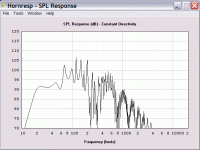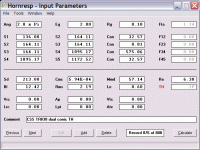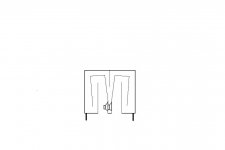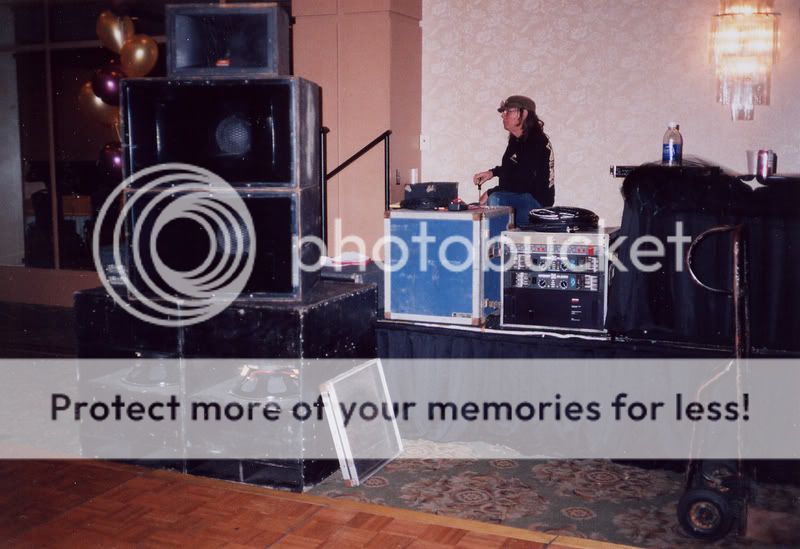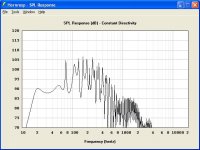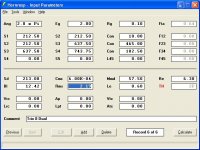aceinc said:Back in post 2775 Tinitus asked about the SCC Trio 8.
I had independently found the same driver, and was thinking about building something similar to the TH-SPUD, or the same horn geometry with a differnt shape, more rectangular, less square.
The drivers are about $80 each which, if I can get close to the TH-SPUD type of performance makes for a fairly cost effective sub. One other benefit of these drivers for a dual driver configuration is that they are 8 ohms, that allows a nice 4 ohm load for the amp.
BTW, I found that the TH-SPUD drawing that is posted in various places when printed makes it easy to estimate the sizes of the wood. For us Yanks, just get a metric ruler, and 1cm = 4".
Here is a link to the Trio 8 spec sheet.; http://meniscusaudio.com//images/CSS TRIO8.pdf
My reason for a rectangular box is I believe I could squeeze an 96" x 11" x 29" box behind my couch with reasonable SAF.
Anyone done modeling of a pair of these yet?
Paul
Look here:
http://www.diyaudio.com/forums/showthread.php?postid=1718548#post1718548
It has been discussed some. The Trio 8 looks impressive, but its parameters are not ideal for use in a tapped horn. Fs is too low, Mms is too low, and Bl is a bit too high.
Rgs, JLH
100mm = 10cm = 1dm = 0.1m ~= 4inchaceinc said:
BTW, I found that the TH-SPUD drawing that is posted in various places when printed makes it easy to estimate the sizes of the wood. For us Yanks, just get a metric ruler, and 1cm = 4".
that predicted frequency response shows peaks at 70Hz and 100Hz and >=120Hz.Originally posted 2802 by GM
Dang! And I thought my sim ~mirrored the SPUD's measured response once TD's comments about smoothing was factored in: 2pi space, 1 W/4 ohms, ~364.5 L:
GM
The discussion has previously agreed that a folded TH will reduce the severity of these peaks.
What cut off frequency would we use in this example? 60Hz active 4pole or some higher frequency?
Do the first and/or second peaks need to be controlled either actively or passively or simply ignored.
?
Hmm, the bends will only quell the extreme HF where it doesn't matter in a TH since even the highest practical XO point will damp them below audibility. TD's comments alludes to there being other considerations that smooth them out considerably as proven by his measurements. Not having actually built/measured a TH I can only speculate what's doing it and how it might be designed in or at least increased over the norm, so at this point not sure whether or not to ignore the peaks. Simming WC's THs and comparing them to his measurements should help in deciding what can probably be ignored.
With today's digital EQ/adjustable XOs though, it seems to me that where the driver is near the ends that the XO can be as high as the driver's mass corner if 4th order and it's positioned to blend well to the mains once any time delay is accounted for, so in theory there's lots of tuning flexibility with a high mass corner driver.
Bottom line, just like with any work to be done (speaker alignment), choosing the right tool (driver) for the job (desired alignment/bulk) will be the most efficient (minimize all these issues).
GM
With today's digital EQ/adjustable XOs though, it seems to me that where the driver is near the ends that the XO can be as high as the driver's mass corner if 4th order and it's positioned to blend well to the mains once any time delay is accounted for, so in theory there's lots of tuning flexibility with a high mass corner driver.
Bottom line, just like with any work to be done (speaker alignment), choosing the right tool (driver) for the job (desired alignment/bulk) will be the most efficient (minimize all these issues).
GM
JlH;
Thanks for the post. It is my understanding that the TH-SPUD cannot be modeled by HornResp, since it acts as dual horns.
Being of a simple brain, I have not mastered akabak. When trying to model something like the TH-SPUD in akabak do you make a section for each of the bends?
Has anyone been able to make a model of the TH-SPUD, that comes close to the published specs?
If so has anyone tried to back into spec's on drivers that might make it work?
My seat of the pants measurements seem to indicate a throat of about 34 sq. in. and a 119 sq. in. mouth with a 227 in. length. It would appear that the drivers are mounted about 41 in. from the mouth, and 0 in. from the throat.
How accurate are the dimensions of the drawing floating about labeled "Couch Sub... (Drawn by TW)..." when compared to the final TH-SPUD? Anyone know? Feel free to chime in Tom, if the spirit moves you.
A question for the folks that have built tapped horns, has anyone taken a design and compared the modeled measurements against the actual? What were the results?
Secondly, has anyone taken a cabinet built for one driver and tested it with other driver(s) with dissimilar specs? What were those results?
Paul
Thanks for the post. It is my understanding that the TH-SPUD cannot be modeled by HornResp, since it acts as dual horns.
Being of a simple brain, I have not mastered akabak. When trying to model something like the TH-SPUD in akabak do you make a section for each of the bends?
Has anyone been able to make a model of the TH-SPUD, that comes close to the published specs?
If so has anyone tried to back into spec's on drivers that might make it work?
My seat of the pants measurements seem to indicate a throat of about 34 sq. in. and a 119 sq. in. mouth with a 227 in. length. It would appear that the drivers are mounted about 41 in. from the mouth, and 0 in. from the throat.
How accurate are the dimensions of the drawing floating about labeled "Couch Sub... (Drawn by TW)..." when compared to the final TH-SPUD? Anyone know? Feel free to chime in Tom, if the spirit moves you.
A question for the folks that have built tapped horns, has anyone taken a design and compared the modeled measurements against the actual? What were the results?
Secondly, has anyone taken a cabinet built for one driver and tested it with other driver(s) with dissimilar specs? What were those results?
Paul
GM said:Dang! And I thought my sim ~mirrored the SPUD's measured response once TD's comments about smoothing was factored in: 2pi space, 1 W/4 ohms, ~364.5 L:
GM
Your input parameters must be different than mine. I could not get is to look like yours even with some slight changes. What are your input parameters for the simulation?
Rgs, JLH
A question for the folks that have built tapped horns, has anyone taken a design and compared the modeled measurements against the actual? What were the results?
Secondly, has anyone taken a cabinet built for one driver and tested it with other driver(s) with dissimilar specs? What were those results?
William Cowan did both of those things. The results are on his website. Also, there was a measurement a few pages back in the thread but I can't remember who did it or where it was.
I used the linked published specs and just 'ran the numbers' on single and dual driver variants the same way I do for any TH sim I've posted to see if it was a potential TH woofer/sub driver, making no attempt to conform to the so-called SPUD drawing since I assumed it was only somebody's guess and noticed that the dual might be 'close enough' WRT the SPUD's measured response and small enough that it could probably be folded to fit into Paul's desired cab dims, though of course like any such sim it may be worthless if the specs are too far off.
I obviously disagree with your assertion that its published specs aren't suitable for a DIY HIFI/HT 'sub' TH, though making the dual a push-pull layout is more trouble than it's worth IMO for these apps, especially if you're going to sit on it, though it may need a bit more bracing around the drivers if (over) driven to meet DD/DTS/THX reference level down low with only a single sub in 2pi space. In this layout, best to use two (four drivers) as recommended for the SPUD.
GM
I obviously disagree with your assertion that its published specs aren't suitable for a DIY HIFI/HT 'sub' TH, though making the dual a push-pull layout is more trouble than it's worth IMO for these apps, especially if you're going to sit on it, though it may need a bit more bracing around the drivers if (over) driven to meet DD/DTS/THX reference level down low with only a single sub in 2pi space. In this layout, best to use two (four drivers) as recommended for the SPUD.
GM
Attachments
G'day Paul
Have you worked out the distance between the drivers as a fraction of a wavelength at 100Hz? If you did you would realise the drivers are so close together they can be considered as one.
No
Yes and Yes.
My models suggest this is the real deal, or at least very close. You won't learn much by just copying a Turn-Key design. The biggest benefit of DIY is you get exactly what you want, not what some designer thought you wanted. And you learn some along the way.
Why don't you build and measure some?? I've modeled, built and measured many tapped horns. Some info on these can be found on my webpage. Too many people are expending too much time playing with potentially misleading models and not building and measuring these things. The models that do not include real world losses can only show so much of what is happening in a tapped horn.
Cheers
William Cowan
aceinc said:
It is my understanding that the TH-SPUD cannot be modeled by HornResp, since it acts as dual horns.
Have you worked out the distance between the drivers as a fraction of a wavelength at 100Hz? If you did you would realise the drivers are so close together they can be considered as one.
aceinc said:
When trying to model something like the TH-SPUD in akabak do you make a section for each of the bends?
No
aceinc said:
Has anyone been able to make a model of the TH-SPUD, that comes close to the published specs?
If so has anyone tried to back into spec's on drivers that might make it work?
Yes and Yes.
aceinc said:
How accurate are the dimensions of the drawing floating about labeled "Couch Sub... (Drawn by TW)..." when compared to the final TH-SPUD? Anyone know?
My models suggest this is the real deal, or at least very close. You won't learn much by just copying a Turn-Key design. The biggest benefit of DIY is you get exactly what you want, not what some designer thought you wanted. And you learn some along the way.
aceinc said:
A question for the folks that have built tapped horns, has anyone taken a design and compared the modeled measurements against the actual? What were the results?
Secondly, has anyone taken a cabinet built for one driver and tested it with other driver(s) with dissimilar specs? What were those results?
Paul
Why don't you build and measure some?? I've modeled, built and measured many tapped horns. Some info on these can be found on my webpage. Too many people are expending too much time playing with potentially misleading models and not building and measuring these things. The models that do not include real world losses can only show so much of what is happening in a tapped horn.
Cheers
William Cowan
dwk123 said:Okay, not a tapped horn post, but I guess tangentially related. I've seen several folks raise the question of whether a tapped horn has any advantage over a 6th order bandpass. My preliminary WinISD bandpass models weren't too encouraging, but when I realized that Hornresp would happily model them, I figured I'd try.
I've been running a tapped horn and two bandpass subs simultaneously for half a year, hear are some thoughts on the two designs:
http://www.diyaudio.com/forums/showthread.php?s=&postid=1725381#post1725381
GM said:I used the linked published specs and just 'ran the numbers' on single and dual driver variants the same way I do for any TH sim I've posted to see if it was a potential TH woofer/sub driver, making no attempt to conform to the so-called SPUD drawing since I assumed it was only somebody's guess and noticed that the dual might be 'close enough' WRT the SPUD's measured response and small enough that it could probably be folded to fit into Paul's desired cab dims, though of course like any such sim it may be worthless if the specs are too far off.
I obviously disagree with your assertion that its published specs aren't suitable for a DIY HIFI/HT 'sub' TH, though making the dual a push-pull layout is more trouble than it's worth IMO for these apps, especially if you're going to sit on it, though it may need a bit more bracing around the drivers if (over) driven to meet DD/DTS/THX reference level down low with only a single sub in 2pi space. In this layout, best to use two (four drivers) as recommended for the SPUD.
GM
Have a closer look at what I actually wrote here:
http://www.diyaudio.com/forums/showthread.php?postid=1723519#post1723519
You’ll see I didn’t say the specifications of the SPUD are unsuitable for HIFI/HT use. I said the Trio 8 woofers I was discussing with Paul were not very suitable for a tapped horn design due to their T/S parameters.
Since you didn’t use the published drawling provided by TW to generate your input parameters we are comparing apples to oranges and your example is not valid to the discussion. Anybody here can “home cook” a tapped horn. I was attempting to model the real SPUD in order to learn something more from it. I’ve already built several tapped horns and don’t need to copy someone’s work. However, I’m always looking for new knowledge.
Push-pull might be more trouble than its worth in your Opinion, but in my Experience it is well worth it.
Rgs, JLH
GM, where did you get the Bl from?
Below is an approximation based on the Couch Sub drawing with the Trio 8 plugged in. Efficiency seems a little light at 90 DB, but the rest looks decent I think. In looking at the nasty spikes starting at about 70hz, I believe that based on posts earlier in the thread, they should be tamed by a hemholtz type of action.
The varying length folds all appear to be in the 70-100 hz range at 1/4 wave length.
Anyone want to poke holes at the assumptions and results have at it. I will post the input parameters in the next post.
Below is an approximation based on the Couch Sub drawing with the Trio 8 plugged in. Efficiency seems a little light at 90 DB, but the rest looks decent I think. In looking at the nasty spikes starting at about 70hz, I believe that based on posts earlier in the thread, they should be tamed by a hemholtz type of action.
The varying length folds all appear to be in the 70-100 hz range at 1/4 wave length.
Anyone want to poke holes at the assumptions and results have at it. I will post the input parameters in the next post.
Attachments
As promised here are the input parameters.
My assumption is that the exterior dimensions are 48" x 45" x 11" which should yield about an 8-1/2" height (width?) in the interior of the horn.
Has anyone else tried to measure the Couch Sub drawing? Are my numbers close?
Paul
My assumption is that the exterior dimensions are 48" x 45" x 11" which should yield about an 8-1/2" height (width?) in the interior of the horn.
Has anyone else tried to measure the Couch Sub drawing? Are my numbers close?
Paul
Attachments
- Home
- Loudspeakers
- Subwoofers
- Collaborative Tapped horn project
